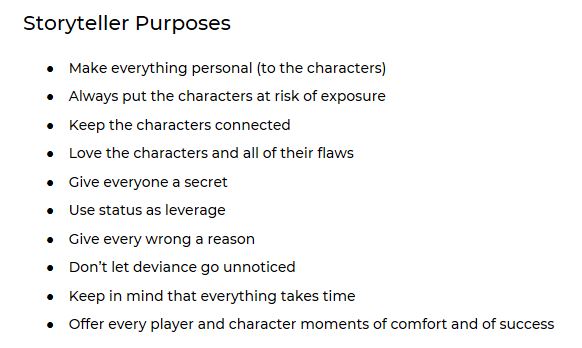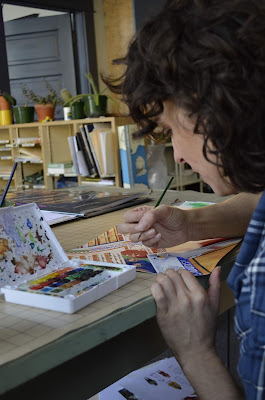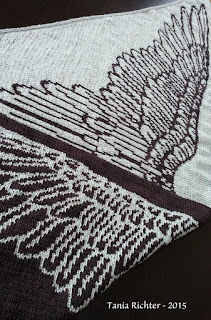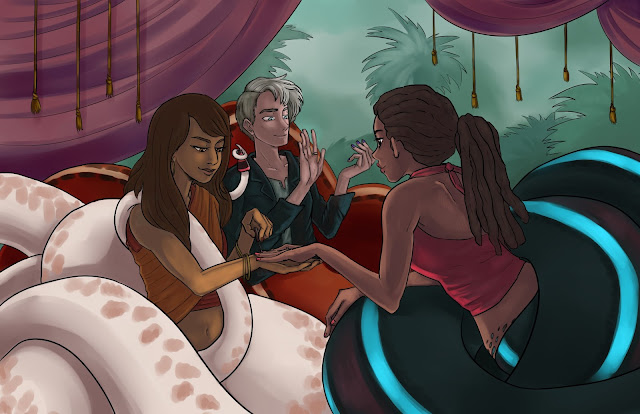 |
| Chris Evans is a representation for me, the log is my fear of running games. |
- minor changes to Human role abilities for clarity
- minor changes to Beast archetype powers for clarity
- adjustment to refresh for exposure
- integrated essay content
- more Storyteller content
- how to on session 0
- session checklist
- explanation of rules
- character creation
- an entire player's guide to all of the roles and archetypes
- elaboration on some mechanics
- rewritten elaboration on mechanics
- complete step-by-step on how to start a game of Turn
I'm hoping to talk about a variety of these things over time, but the biggest one I wanted to talk about is the Storyteller's Guide and how that came to be.
 |
| The Storyteller Purposes were actually written by dictation to John while we were driving across the state last year. |
I am not a particularly gifted facilitator, especially not in an actual "game master" type of role. I avoid it like the plague because it stresses me out, I don't feel like I do a good job, and I don't have experience in it. However, for Turn, I have very clear ideas on how the game should work. It's the only game I've run 4 sessions of, ever. But I didn't write any of these ideas down.
So, when John and I went to the lake cabin (my parents'), he asked me a ton of questions. I answered as best I could, and realized I kind of had to write all of it down. Since then I've been adding text to the Turn document like wild! I have a lot of ideas for how to solve the little issues people have come up with before I made the changes, but I have no idea if they'll work for people other than me.
To some kind of credit, I did try out the first draft of the "how to set up Turn" the other night and it went awesomely. I even did the new Session 0! And it worked great. I've added some detail since then, so I hope it'll work. Here's some things I wrote about, which are in addition to the materials I'd already written:
Character Creation
This has guidance on helping the players answer questions about their characters, how to handle animal groups, a note on NPCs, and special rules for some of the roles. It's stuff that I know will come up, but didn't write down. Some of this is just hard to figure out how to word, or I hadn't had time to put on paper. Some things I just didn't know needed written guidance, but it did - like the special rules for the Late Bloomer or the NPCs. But, now it's written down!
 |
| The Beastborn and Wolf character sheets for John's character in my new game, created by John W. Sheldon. |
This is how to actually get the game going. It directs the Storyteller to the Beginning Your Game section and then walks them through a structured first couple scenes. I'm really pleased with it and when I tested it out it went amazingly well, for someone like me to run, so I'm glad it's on paper. I had to really separate out what was important in a first session, and I think that this meets it - connecting the characters, placing them within the town, and establishing the personality of the characters.
Running an Average Session
This covers the typical things a Storyteller will encounter in a session of Turn. Some people had expressed they weren't sure how to engage stress or how to run beast scenes, so I wrote up some details on that to get people really on the same page. This involved writing up how you should pepper each session with mundanity - everyday tasks that will stress out shifters - and beast issues like territory and habitat struggles.
I also included a Storyteller Session Checklist that makes sure that there are NPC to PC connections, PC to PC connections, gossip, mundane vignettes, and beast scenes alongside the human scenes everyone leans to. I'm pleased with it!
Tracking Goals
This section was to make more concrete guidance on how to handle players trying to achieve goals. It includes guidance on using progress bars based on difficulty, and how that comes across for each goal. I needed to give a more solid way to mark and record this so that there wouldn't be unfair imbalance in how quickly some goals were achieved. Plus, this way the Storyteller can have visual representation of the progress.
 |
| A closeup of the character sheets - wolves have packs in the game, did you know? by John W. Sheldon. |
After I'd made a small change to the refresh rate for exposure, I realized I'd never noted that animal group stress doesn't refresh. I fixed that, and then wrote up some rules on how Storytellers will use a progress bar to help shifters reintegrate with their own group or find a new group, based on difficulty. I think that this, the explanation of exposure, and my new guidance on beast scenes will help Storytellers more actively engage that material.
-
Overall this has been a heck of a lot of work. This is only the ONE section, out of all of the ones in my bulleted list up top. The thing is, I'm not really changing rules for 90% of this - I'm just explaining stuff. More of this whole project is explaining things than I ever thought it'd be, and I'll tell you, I'm hoping that this makes a difference when people get into the text!
One of the hardest things I've had to do is make guidance for Storytellers. It's not something I do a lot, and honestly, a lot of people in that role are people I don't actually enjoy working with (just a personality thing, maybe?). I don't necessarily want Storytellers in Turn to work the same way a D&D GM would, or even a Fate GM. I want them to care a lot more. It's a heavy workload to run the game, by many people's counts, especially for a "story game" sort of game - but I wouldn't have it any other way.
I started a game on Friday as Storyteller, and we have a fantastic group of a Late Bloomer otter, a Showoff raven, and a Beastborn wolf in a town full of intrigue because the shifters know who each other are and there's formal shifter culture, and it's incredibly exciting to think of the places it could go. I know I'm gonna have a lot of little progress bars and it's gonna be exciting to mark each one off. I can't wait!
 |
| Our town, Script Change, and the Human Form struggles - just the stuff I was reviewing while I was taking a break. |
There's so many things I love about game design, and as hard as it can be to do it on spare dollars, I can't ever stop being amazed by how much it teaches me. It is a constant learning experience, and I'm very glad that my time spent digging into Turn's mechanics and text has encouraged me to do something I find terrifying - and made it exhilarating instead!
It's awesome, and so is Turn. Check it out if you want to see the hard work I've been putting in! Thanks for reading <3
This post was supported by the community on patreon.com/briecs. Tell your friends!
To leave some cash in the tip jar, go to http://paypal.me/thoughty.
If you'd like to be interviewed for Thoughty, or have a project featured, email contactbriecs@gmail.com.
































